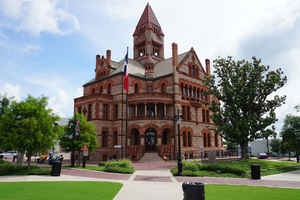Texas Counties
Texas is divided into two hundred and fifty-four counties, more than any other state. Texas was originally divided into municipalities, a unit of local government under Spanish and Mexican rule. When the Republic of Texas gained its independence in 1836, there were 23 municipalities, which became the original Texas counties. Many of these would later be divided into new counties. The most recent county to be created was Kenedy County in 1921. The most recent county to be organized was Loving County in 1931Hopkins County, Texas
Hopkins County Education, Geography, and History

Hopkins County is a county located in the state of Texas. Based on the 2010 census, its population was 35,161.[ Its county seat is Sulphur
Springs. Hopkins County is named for the family of David Hopkins, an early settler in the area.
Hopkins County comprises the Sulphur Springs, TX Micropolitan Statistical Area, which is included in the Dallas-Fort Worth, TX Combined
Statistical Area.
Etymology - Origin of Hopkins County Name
the family of David Hopkins, an early settler in the future county
Demographics:
County QuickFacts: CensusBureau Quick Facts
Hopkins County History
Hopkins County is a county located in the US state of Texas. Its seat is Sulphur Springs. Hopkins County is named for the family of David Hopkins, an early settler in the area.
Handbook of Texas Online
The area that became Hopkins County was originally occupied by the Caddo Indians, who were later displaced by the
Cherokees. Troops dispatched by the Republic of Texas under the command of Gen.
Kelsey H. Douglass defeated the Cherokees in 1839. This event encouraged
settlers, now relatively free from Indian attacks, to move into what is now Hopkins County. A grave marker near the
first white settlement, Sulphur Bluff, indicates that settlers were in the area by 1837. Hopkins County was created
from parts of Lamar and Nacogdoches counties in March 1846 by the first Texas state legislature. It was named for
the David Hopkins family of pioneers. The county seat was established at
Tarrant, about five miles north of Sulphur Springs, and remained there until 1870, when the state legislature
officially made Sulphur Springs the seat of county government. The territory of the original 1846 Hopkins County was
subsequently reduced several times. In 1870 a part of its southwestern corner was given to Rains County, and land
north of the South Sulphur River was given to Delta County. In 1871 a small tip of Hopkins County's northeastern
corner was given to Lamar County. Hopkins County was settled mainly by southerners; it had a population of 2,623 by
1850. Slavery and cotton culture did not
play a dominant role in the county before the Civil War. The census of 1850
enumerated 154 slaves in Hopkins County, less than 6 percent of the total population; that same year no cotton was
reported planted in the county. The county population increased threefold during the 1850s. On the eve of the Civil
War the census of 1860 reported 7,875 inhabitants, of which just under 1,000 were black. Corn and wheat were the
main crops, and cattle and sheep ranching were also important, with almost
22,000 head of cattle and more than 36,000 sheep in the county that year. More at
Bob and Michelle Gilbert, "HOPKINS COUNTY," Handbook of Texas Online (http://www.tshaonline.org/handbook/online/articles/hch18),
accessed January 24, 2016. Uploaded on June 15, 2010. Published by the Texas State Historical Association.
Geography: Land and Water
As reported by the Census Bureau, the county has a total area of 793 square miles (2,053 km2), of which, 782
square miles (2,026 km2) of it is land and 11 square miles (27 km2) of it (1.31%) is water.
Neighboring Counties
Bordering counties are as follows:
- Delta County (north)
- Franklin County (east)
- Wood County (south)
- Rains County (southwest)
- Hunt County (west)
Education







